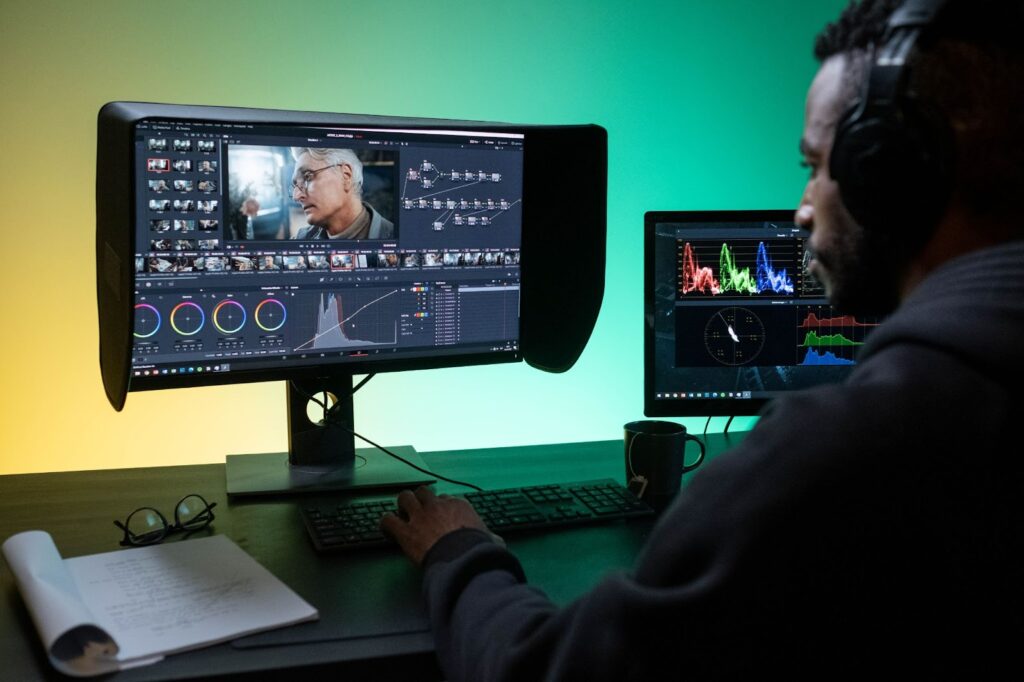
Post-Production in Corporate Videos: How to Make Yours Shine
As we mentioned earlier, the quality of your corporate video will largely be determined by how well it is edited. A poorly edited video can be confusing, boring and even off-putting to viewers.
On the other hand, a well-edited video will flow smoothly and keep the viewer engaged from beginning to end. It’s important to remember that your corporate video is an investment, and you should treat it as such. Hiring a professional editor is worth the cost if it means creating a high-quality final product – and it’s even better when you get servicing for completing your production from a team that understands how to bring your vision to life with expert finishing, sound design, and visual polish.
Achieving such a polished outcome often extends beyond just the editing suite, requiring a cohesive effort from a dedicated production crew. From initial concept development and strategic planning to meticulous filming and expert post-production, every stage contributes to a video’s overall impact. Businesses looking to elevate their brand presence through compelling visual narratives understand the value of partnering with experienced professionals. For those in Queensland seeking comprehensive services, an Ipswich video production team can provide the expertise needed to transform ideas into world-class cinematic content. This holistic approach ensures that the final video not only looks professional but also effectively communicates the desired message and achieves marketing goals.
What is post-production?
Post-production is the process of editing and assembling your video footage to create the final product. This includes tasks, such as adding graphics, music and transitions.
It is important to note that post-production is not simply about putting all of your footage together in a linear fashion. A skilled editor will be able to take your raw footage and craft it into a story that engages the viewer and communicates your message effectively.
Why is post-production important?
As we mentioned earlier, the quality of your corporate video will largely be determined by how well it is edited. A poorly edited video can be confusing, boring and even off-putting to viewers.
On the other hand, a well-edited video will flow smoothly and keep the viewer engaged from beginning to end. It is important to remember that your corporate video is an investment and you should treat it as such. Hiring a professional editor is worth the cost if it means creating a high-quality final product. Meanwhile, experts providing services like corporate videography on the gold coast (or elsewhere) can handle everything from shooting to post-production, ensuring a polished, engaging video that effectively communicates your message.
Top-notch post-production tips
Now that we’ve discussed why post-production is so important, let’s take a look at some tips on how to make yours shine:
1. Work with a video production company for corporate affairs.
This is the most important tip on our list. As we mentioned before, a skilled video editor can take your raw footage and turn it into a work of art. If you don’t have any experience with video editing, we strongly recommend working with a professional. They will be able to help you select the best footage, add graphics and transitions and create a final product that you can be proud of.
2. Don’t be afraid to experiment.
One of the great things about post-production is that it gives you the opportunity to experiment. If you’re not happy with how something looks, you can always go back and change it. So don’t be afraid to try out different ideas and see what works best for your video.
3. Pay attention to the details.
The details are what will make your video really shine. Small things like choosing the right music or adding a subtle graphic can make a big difference in the final product. So take your time and pay attention to the little things.
4. Make sure your video is properly formatted.
When you’re exporting your video, make sure to use the correct file format. Different platforms require different formats, so it’s important to check before you export. This can save you a lot of time and hassle down the road.
5. Pay attention to audio quality.
The audio in your video is just as important as the visuals. Be sure to use high-quality microphones and record in a quiet environment to get the best sound possible. Poor audio can ruin an otherwise great video, so don’t overlook this step!
6. Give yourself enough time.
Don’t wait until the last minute to start working on your post-production. The more time you give yourself, the better your video will be. This is especially true if you’re working with a professional editor. They will need time to go through all of your footage and make sure everything is just right.
We hope you found these tips helpful! Remember, post-production is an important part of creating a high-quality corporate video. If you keep these tips in mind, you’ll be well on your way to making yours shine.
Read More : Post-production services encompass a range of creative and technical processes that refine and enhance audiovisual content, bringing it to its final polished form. From editing and visual effects to color grading and sound design, these services play a crucial role in delivering a captivating and immersive viewer experience.